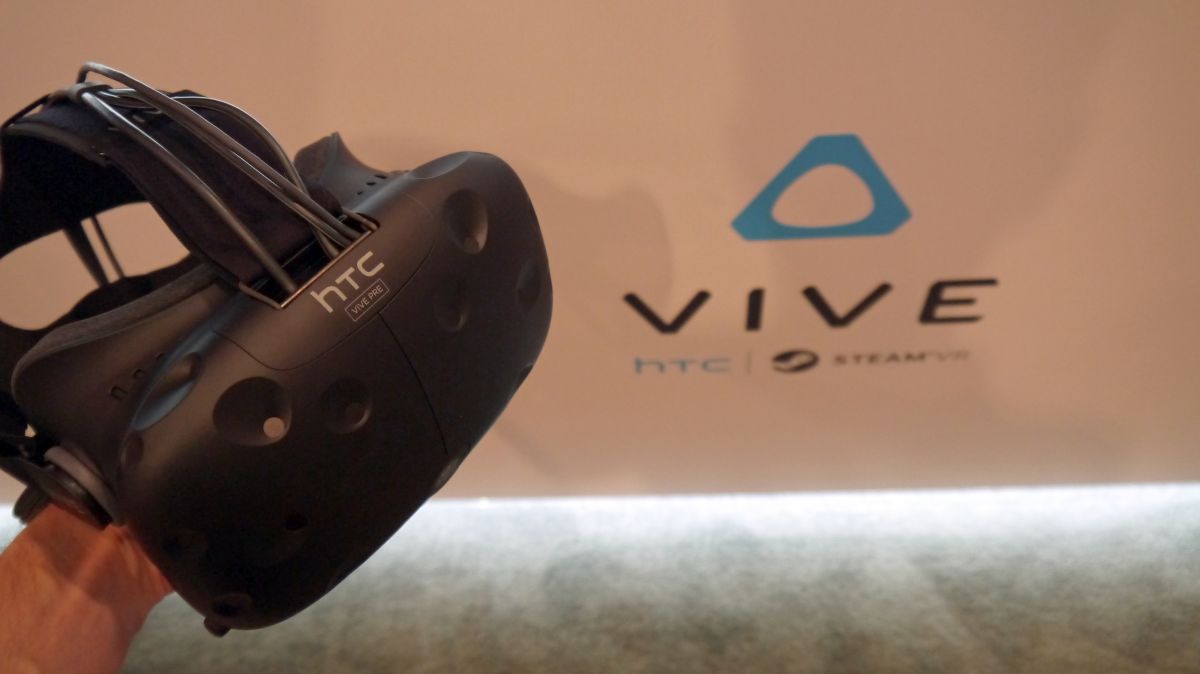
HTC Vive review
Before trying out the HTC Vive at GDC 2016, I signed an agreement that said I couldn’t give you a full review of the system. I was told to avoid using strong language and to keep in mind that the demos I saw weren’t the final versions.
In more or less words I was told not to pan the HTC Vive before it came out of the oven.
But giving journalists a warning to avoid using derogatory language when talking about the Vive is like telling someone not to lick a coin you found on the street sidewalk: you don’t need to be told not to do it and, more importantly, there’s no way in hell you’d do it anyways.
Why? Because the HTC Vive is the best virtual reality headset on the market, bar none. (Apologies for using definitive language.)
Tracking is one-to-one; the field of view is perfectly natural; there’s nary a screen tear or dropped frame when you’re using the right equipment; movement feels natural; the controllers are best-in-class; and the experiences, the demos and the games available through SteamVR, simply blow the competitors away.
The headset will start shipping in April and, thanks to a partnership with Valve, it will launch with dozens of games and experiences for you to try on day one.
I know they told me I can’t give the Vive a rating but, if I could, it would be an 11 out of 10.
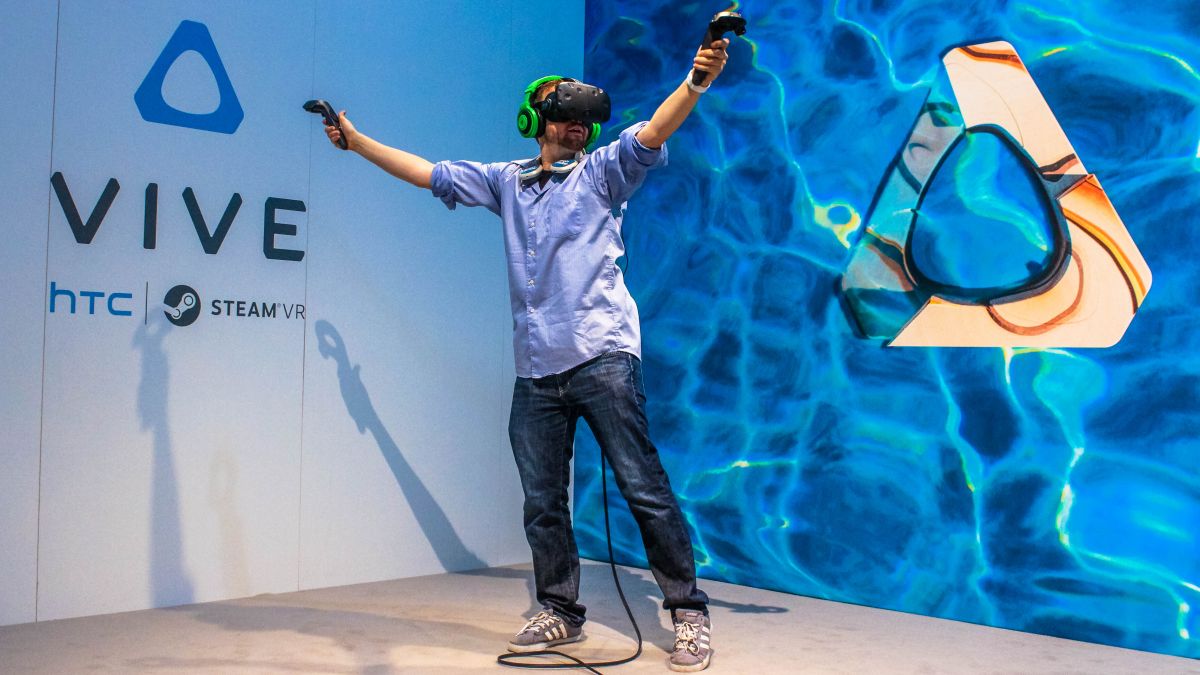
But dissenters are never pleased. I can almost hear them now. “For one,” they’ll say, “it’s going to be expensive.”
The headset itself sells for $799 / £689 / €899, and that’s before you buy a computer with the recommended Intel i5-4590K or better CPU and Nvidia GTX 970 or AMD 290 graphics card.
For comparison, the Vive costs twice as much as the PlayStation VR (before buying a capable gaming PC) and $200 more than Oculus Rift. Now, ultimately I think you’ll find that it’s worth the extra cash for a better experience, but $800 probably isn’t the kind of money you can just spend at the drop of a hat either.
That’s a fair argument, albeit one that we can do almost nothing about right now. New hardware, especially of this caliber, is going to be expensive.
But wait, why is it so expensive? What exactly does it do? Read on to find out.

How does the HTC Vive work?
The first time we got our hands on the HTC Vive was at MWC 2015, where the phone manufacturer first made the announcement of its partnership with Valve, and it has been retooled and vastly improved since that original showing.
The latest version works wonderfully and feels ready to be shipped to the public which, considering that units are supposed to go out in April, is a good thing.
Like other virtual reality headsets, the Vive has the arduous task of completely immersing you in a video game by producing two images simultaneously. However, unlike PlayStation VR and Oculus Rift that use a single camera to track your head and extremities, HTC Vive has two base stations, which sit on the wall or a high shelf to help map the space you can walk around in 3D.
What the stations track are small divots on the top of the two controllers and on the headset itself. There are probably close to a dozen of these dots speckling the controllers and helmet that help accurately track the Vive.
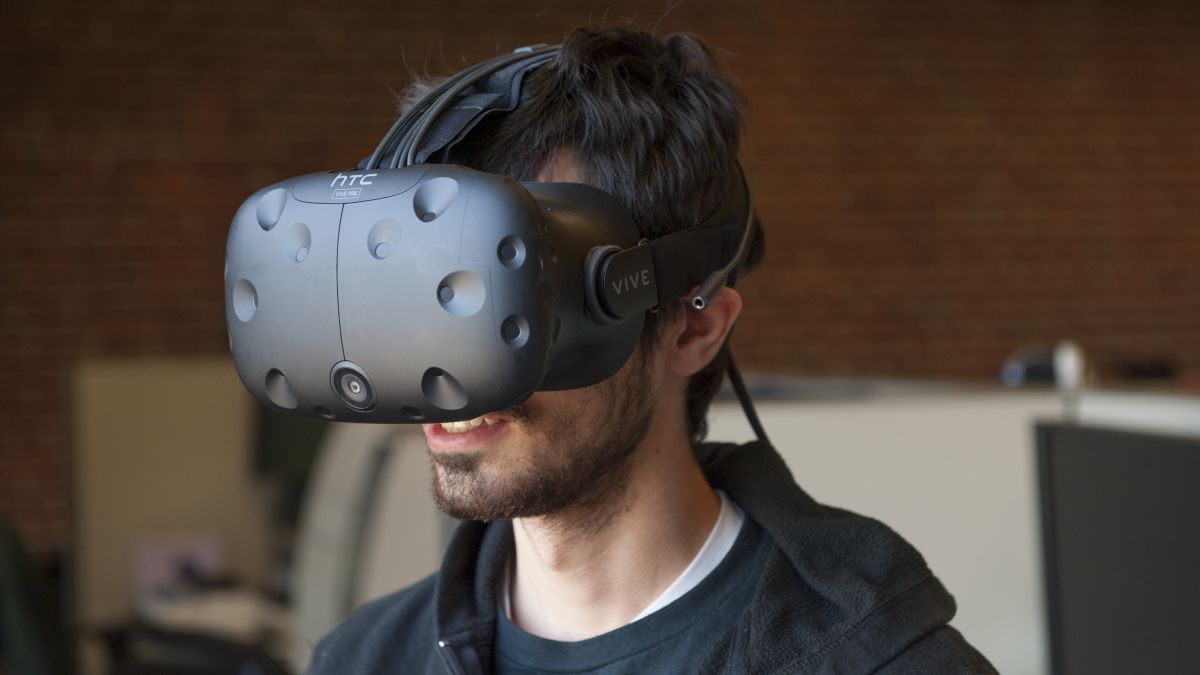
Inside every box is a Vive headset unit, two controllers, two base stations, a cloth to wipe down the screen, a processing box that sits between the headset and your PC, charging cords for the controllers and power cables for base stations. It’s everything you’re going to need for a great virtual reality experience minus the GPU to power the whole thing.
Once you’re plugged in and the room has been mapped out, you’re free to roam around every inch of the digital space. This means digital worlds can be more expansive and more immersive on the Vive than the other two systems and, thankfully, less nausea-inducing, too.
The only limitations you’ll encounter once inside your digital world are faint blue walls that keep you inside the playzone. These blue lines are superimposed into your game by SteamVR, the software put out by Valve that’s running underneath every virtual experience. It’s called “chaperone mode,” and its practical application is to prevent you from moving too far outside the area that you’ve set up in your home for the Vive and potentially stumbling into furniture/plants/animals/etc and hurting yourself.
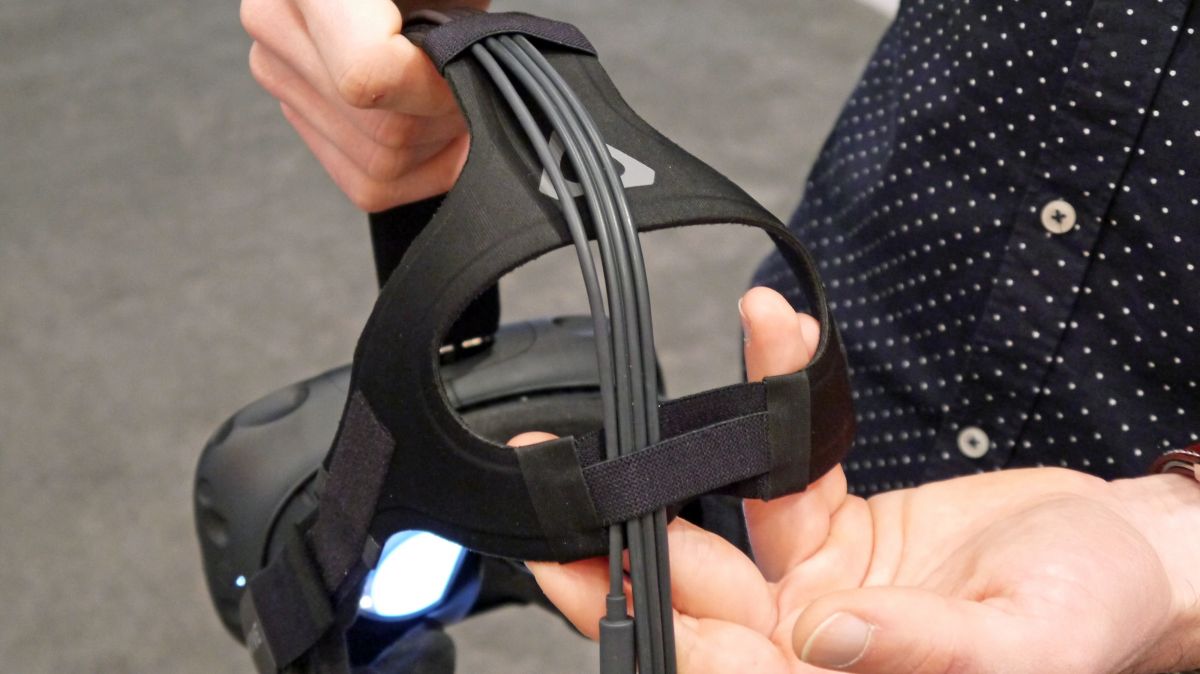
As for the games themselves, they’re simply amazing. In a short demo at GDC I got to play three titles that, if I had my way, I would’ve never put down. I’ll cover them in detail in a moment but, in short, they were fantastic, full of personality and just as varied as you might expect. One minute I was on top of a castle fending off stickman invaders with a bow and arrow, the next I was inside of an arcade cabinet fighting spaceships in three dimensions. Finally, I was taken to Tatooine where Han Solo tasked me with repairing the Millennium Falcon and fighting off a squad of Stormtroopers with a lightsaber.
Much of what I just described is part of Valve’s The Lab, a collection of games that the legendary developer put together to introduce players to virtual reality. While I haven’t seen as many third-party titles on Vive as I have on PlayStation VR, the difference between first-party titles are night and day. Sony’s are cute and ephemeral, while Vive’s are long lasting, completely immersive experiences.
Design
The latest iteration of the HTC Vive is best described as a bulbous visor taken straight from the pages of a science fiction novel.
The headset is covered in tracking divots and sports a camera front and center on its face. The front face is supported by three velcro straps that wrap around the top and sides of the Vive and meet in the back to form a cradle for your noggin. Getting an exact fit takes a bit of trial and error, but once you’re locked in it’s clear sailing.
Inside the headset is a 2160 x 1200 OLED screen that runs at 90Hz. For comparison, that’s slightly less than the PlayStation VR’s 120Hz refresh rate, but because the Vive is running off a more powerful GPU, it’s not exactly apples to apples. You can expect a 110-degree field of view, which is one of the largest available on any virtual reality headset and results in a more immersive experience.
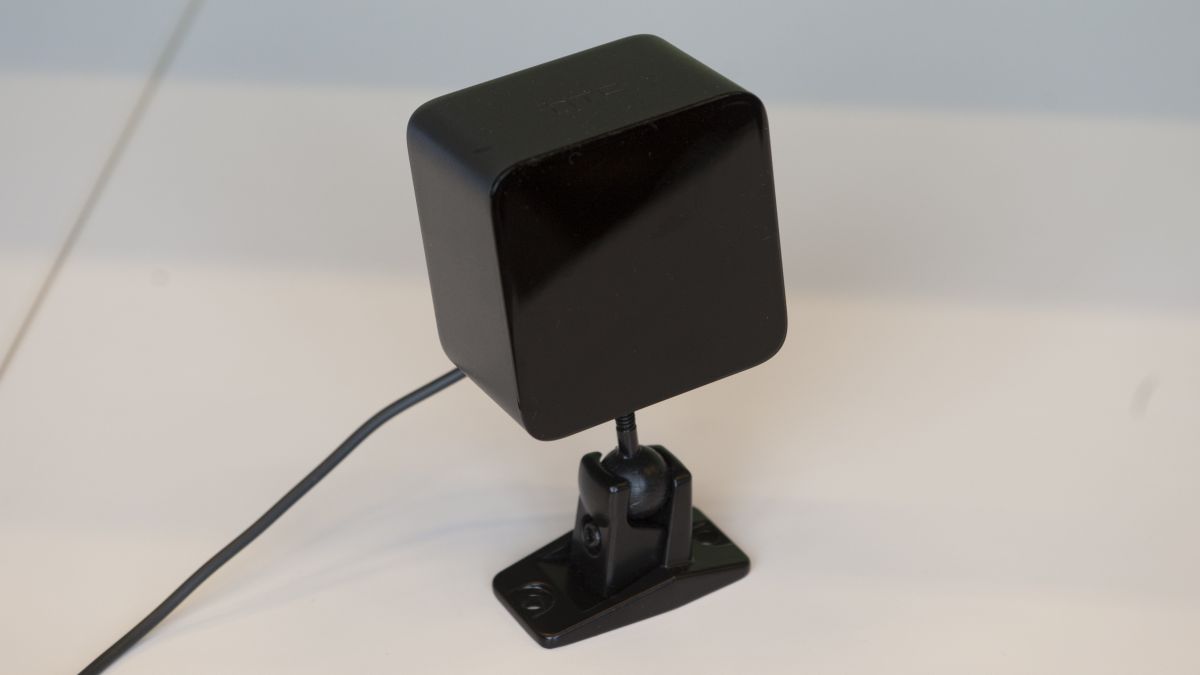
The base stations, which are crucial to mapping the playspace and tracking you as you move about the room, should sit on a nearby wall or high shelf in order to do their job to the best of their ability. The latest version of the stations are smaller, wireless and (apparently) make less noise too, although I didn’t even know they were loud in the first place.
Similarly the controllers are also much more versatile compared to the competition, giving developers many more tools to work with. The touchpads are still there but they’re now clickable, and the rear trigger has two stages to allow for more refined interaction. While they’re a bit bigger in stature than the Oculus Touch or PlayStation Move, the Vive’s controllers function exponentially better than either.
The main buttons you’ll need to familiarize yourself with are start and connect buttons located above and below the touchpad, two side buttons that can be pushed with your ring finger and the palm of your hand and the trigger on the back.
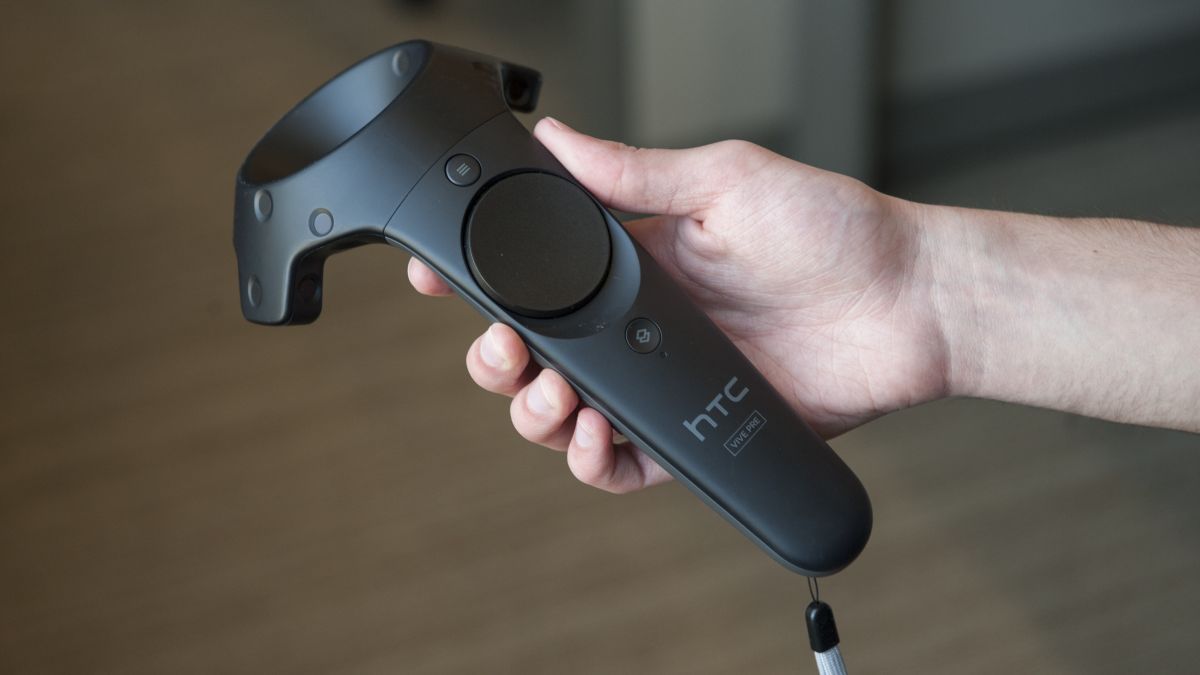
Moving around in-game might take a combination of pressing a trigger and the touch-pad, using a trigger to jump from spot to spot or physically walking from one part of the room to the other, depending on the title. While the Oculus Rift can track a playspace of around 5 x 11 feet and the PlayStation VR can spot you in an area of around 8 x 6 feet, the HTC Vive has a maximum tracking area of 15 x 15 feet. It’s a substantial difference and one that takes VR from a sedentary experience to a truly immersive one.
Performance
So far I’ve used words like “immersive,” “amazing” and “best headset on the market, bar none” when describing the HTC Vive. I could rant for pages and pages how much I enjoyed my time with the headset, but without trying it for yourself it’s tough to fully appreciate just how close to perfect this technology is.
While other systems struggle to keep up with your movements or have a noticeable delay, the Vive can intelligently track exactly where you are in the room and what you’re doing with your hands. That sounds like it should be a given, but you wouldn’t believe how many demos I’ve tried where the system just couldn’t figure out where I was standing or how I was holding my arms.
When you don’t get one-to-one tracking, it’s an absolute nightmare for your brain, creating a sort of cognitive dissonance that makes you feel both nauseated and unnatural. Now sure, there were one or two points during my demo that things didn’t go exactly right (I missed a pretty easy shot with a bow while defending my castle that most fourth graders could make), but those times were far fewer here than on Oculus or PlayStation’s hardware.
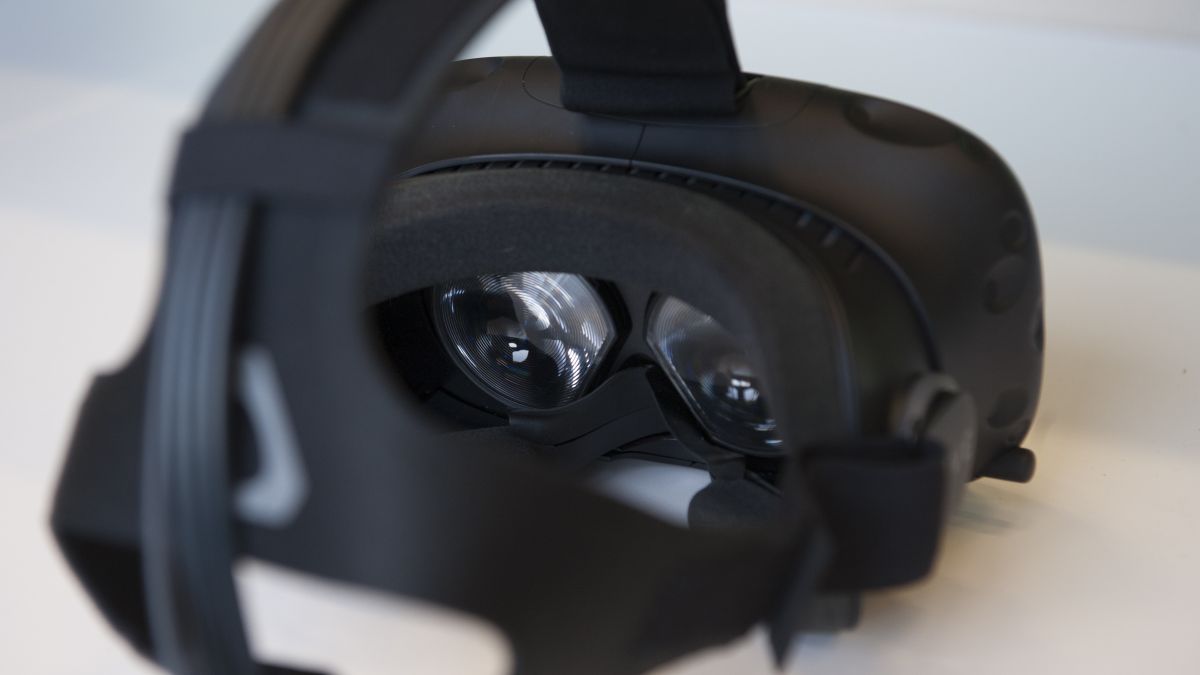
At the heart of this experience is excellent hardware and software. A 110-degree field of view means that games will feel more natural and a larger area to walk around in will keep you from feeling restrained or claustrophobic in your new virtual environment.
Admittedly, this level of perfection isn’t without a price. To start, you’ll need to plunk down $800 / £689 / €899 to buy the unit itself. Then, if you want the minimum recommended specs, it’ll cost you another few hundred for the Nvidia GTX 970 or AMD 290, which currently retail for $320 and around $200, respectively. Then you’ll need a space big enough to fully enjoy your new escape from reality which, if you live in a place like San Francisco, London or New York, can be the most expensive part.
The games and demos you’ll experience on the HTC Vive range in levity, from casual, low-stress romps, to crazy firefights and even a horror title or two to keep you on your toes. While experiences on PlayStation VR are better kept to the former, every demo I’ve tried on Vive felt slick and just all around brilliant.
Here are a few of the experiences – both demos and games – I’ve tried over the past year on the HTC Vive:
The Postcard: At GDC 2016 I was given a personal demo from Valve. Going into it I had no idea what I was going to be shown or how intense the experience might be. I’m thankful that my first experience of the day might’ve also been the most relaxing. The Postcard puts you on a scenic, photorealistic mountainside and only asks you to do one thing: look around. You’re free to walk about, explore and play fetch with a virtual pooch, but there’s no real obligation to do anything else than enjoy the view.

Slingshot: If Valve never gets around to making a Portal 3 and instead only offers us a half-dozen mini-games like Slingshot set in Aperture Labs, I won’t be mad. Slingshot puts you in the middle of Aperture’s warehouse and arms you with a massive mechanical ballista. Your goal? Bring down as many boxes and barrels as you possibly can. Your ammunition? Personality Cores, the wisecracking spheres from Portal 2 that make offhanded remarks about their job and will make you laugh before you send them hurtling to their doom.
Longshot: I liked Slingshot. It was comical, low-stress and barely anything could go wrong. Longshot, on the other hand, wasn’t so forgiving. The demo gives you a longbow and asks you to defend a castle from stick figures who’d love nothing more than to get inside your keep. Aesthetically, it’s nothing like Tolkien’s world of elves, rings and wargs, but I’d be lying if I said I didn’t feel like Legolas standing on top of a turret taking out footsoldiers with every arrow.
Xortex: You gotta love game developers. Even when they’re thinking about the future, they can’t forget about the past. Xortex is Galaga in 3D. You’ll wield your controller like a child holds a paper plane to fly a ship around blowing up enemies, collecting power-ups and avoiding bullets. It combines the addictiveness and simplicity of a game that came out 40 years ago with a technology that wasn’t even invented until last year.
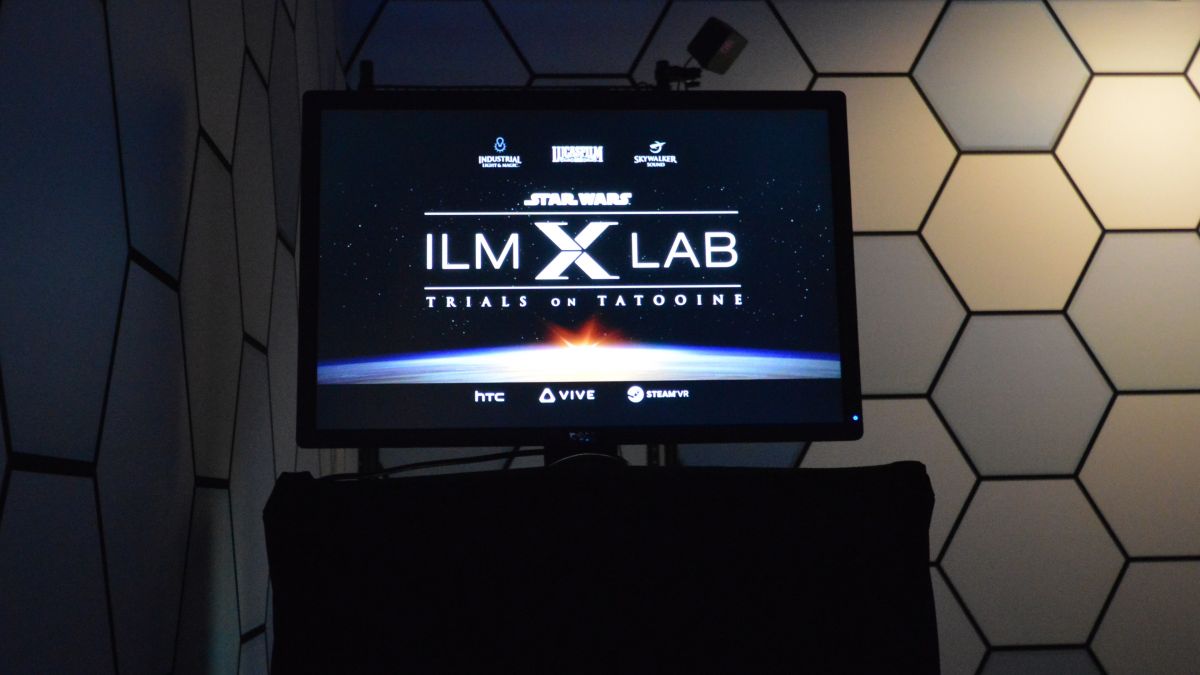
Star Wars: Just when I thought my demo was coming to a close and I had seen all there was to see, I was told to leave the Vive on for one last experience. “I guarantee you’ll recognize it instantly,” my disembodied guide told me from the computer a few feet from where I was standing. He was right. Trumpets blared and large yellow text took over the screen. While I won’t go into too much detail here (you can read about the full experience in Hugh Langley’s Star Wars in VR feature), it was absolutely the highlight of GDC.
While 99% of my experience with the Vive has been an incredible look at the capabilities of virtual reality, there are some parts of the Vive VR experience that aren’t as great as you’d hope – for one, there’s still that damn wire connecting you to your high-end PC, and it’s easy to trip over it when you forget it’s there. You can’t blame HTC too much for this, as the Vive is streaming two distinct Full HD images without a hint of latency, and the gaming experience needs to preserved above all else.
But even Full HD isn’t as clear as you’d want it to be – HTC calls it ‘photorealistic’, but you’d never struggle to tell the difference between a photo and the real world here.
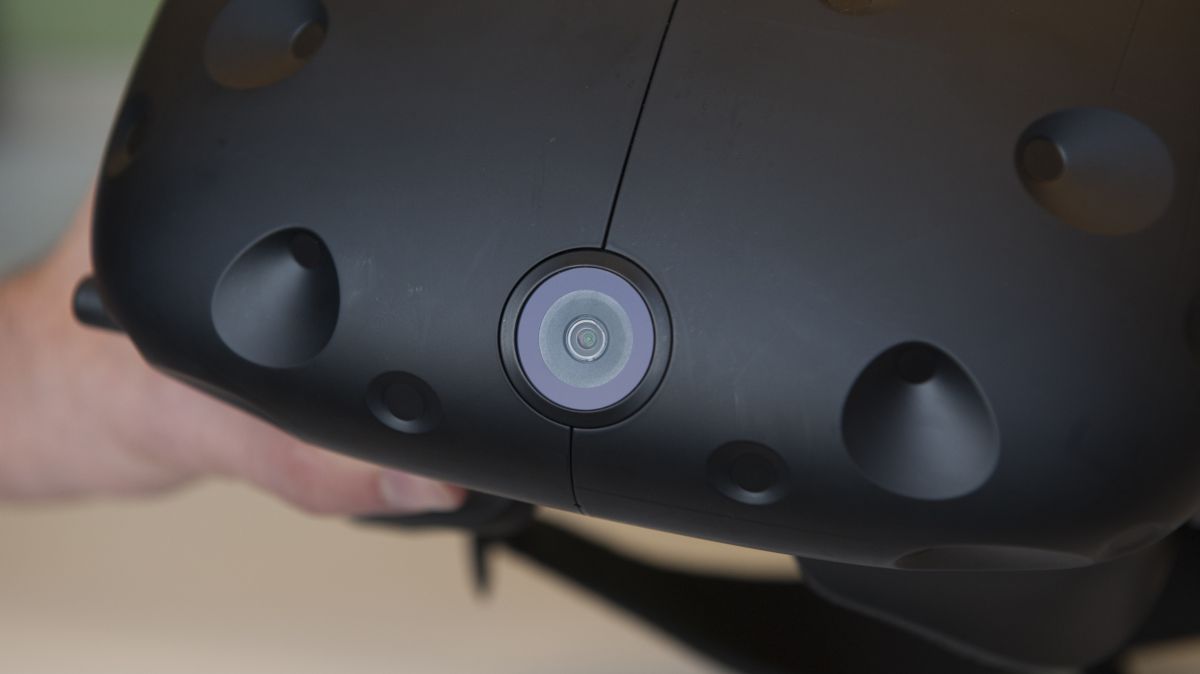
That’s not to say it breaks the immersion when you’re in the VR world, but the Stormtroopers in the Star Wars game were a little rough around the edges when you looked at them properly, and the sheen on the metal girders during Slingshot didn’t quite feel right somehow.
Early verdict
HTC created something amazing with the Vive, and that’s been hugely refined with the latest – and what I can only assume is the final – iteration of the hardware.
It’s more immersive than the competition thanks to the ability to walk around in the space, and the reduction of wires from the base stations and controllers is hugely welcome. Gaming using this, even with short demos, feels like the future, and I can’t wait to try a more active game using these controllers.
I think everyone will wish the resolution was a tad better, but I appreciate that it’s too early in the VR game for that right now. It’s a balancing act between performance, size, resolution and price, and HTC seems like it’s exactly where it needs to be to deliver on all fronts.
Pure and simple, the HTC Vive Pre is awesome. Virtual reality is amazing. And while I signed a paper stopping me from giving you every detail, know that the Vive will be worth every penny of its $799/£689 pricetag when it comes out next month. (Sorry, not sorry.)
Source: techradar.com











































Every time you hear VR lately, you hear room scale, and then you hear the Vive is the only one that can do it.
The Rift can do it as well. There are few games made to take advantage of motion controllers. It hasn't been that long since they were invented for VR. It takes time to make games to use them.
The Rift will have Touch controllers in a few months, and I bet most of the games made for motion controllers will roll out around the same time.
I've seen tons of demos of people playing Vive and Rift games. Not many of people are actually moving more then 2 steps from the center the room where they started. 15×15 is great and all, except when no game is taking advantage of the feature, and when the headset cord wouldn't let you move that far anyway.
I've seen people playing with the touch controllers with no issue, jumping around, moving all about to play, with no problems. That is room scale at work. That isn't just a seated experience. That is on your feet active experience, exactly the same as the Vive videos that are out. From what I understand the newer designed version of touch hasn't been reveal yet. Which would mean, the newer version could be much better.
This review is compare the rift to the vive just as it is, with just 1 camera and the xbox controller, acting like that's all the Rift will ever be, or can be. He leaves out the fact, that both the headsets are practically the same, with most saying that Rift has less Screen Door Effect compared to Vive. In a few months, the new improved Touch controllers will be released, and the differences between the rift and vive will be very small. The touch controller look to be a much better design over the Vive wands.
All 3 headsets are 1:1, not just Vive. Also, those games he played aren't limited to the Vive, they will also be on the Rift.
Personally, I think huge room scale is a gimmick. I just don't see people moving from one end of their room to the other. I don't see how the game is going to make it feel natural to make the player turn at the wall and come back. But playing in a few square feet seems a great deal more logical to me. There are tons of video showing that both the Rift and Vive can do this without issue.
Chaperone mode will also be on the Rift, not limited to only Vive. Value has said so. Odd that this reviewer made it seem like it was only on the Vive.
Luckey said long ago, that the Rift can do room scale and chaperone. It's not a hardware feature, it's a software feature. The rift just hadn't made any games yet that would require the feature, so it wasn't important at that time. But everyone has been running room scale and chaperone into the ground, acting like Rift can't do it, when clearly the Rift can. There just hasn't been any games being demoed by Oculus that makes you have to walk across you room yet, but move around the center of your room sure, no issue. That's really all any of the headsets are showing though.
I bet there is a large portion of the audience that can't use huge room scale because they don't have the space, or some other limiting factor. The only think that will give you true, walking around in a virtual world feel is a virtual treadmill like the Omni.
Each headset will let you dodge, duck, squat, lean, move, jump, and move your arms around till your heart's content. These will be the main actions people will use while playing in VR, and you can do them in all the headsets, not just Vive.
i got my VIVE last week, i love it but i think VIVE will loose the VR war. while the vive only now being released to most developers and consumers. the rift started selling to developers since 2012. which gives it a 4 years lead in developer time. plus facebook budget gives oculus huge game library advantage over the VIVE. room scale is amazing but right now it is limiting in the game design aspect, which makes the 4 years developer gap problem even worse. also public awareness over the VIVE is no where near oculus. i have a lot of HTC products they are amazing but other people never buy them. they don't know how to market their products. i hope this time it will be different but the oculus lead is great and apparent.
For optical reasons, using two cameras for stereo vision only works when watching straight in front of you. Vision gets incorrect as soon as your start moving your eyes around.
I think using a lightfield camera would work but I doubt it would be real-time with today's hardware…
Having that much space is not a requirement. It depends on the game design not the Vive.
I've got a rift DK2, trust me it's way better than cardboard (or even GearVR) as far as immersion and presence. Just positional tracking alone provides that let alone the better FOV etc.
And in Vive's case (as touch is delayed) the ability to properly interact is massive.
Google Cardboard is to Vive VR like a sega master system is to a PS4. It's not hyperbole it's true. REAL VR involves presence, proper input, positional tracking and full immersion. Cardboard has none of that. Then of course you compare a mobile phone to a TOP spec PC with much better gfx.
I played alien isolation on the DK2 (which is no where near as good as Vive is going to be) and it blew my mind, I felt exactly like I was there at times in that place (or places) not just some gimmicky 3D Diorama with a bit of head tracking like Cardboard is.
I can't wait to see what software Valve put out for Vive, I'm sure it'll be stunning and really live up to what VR should be about.
Oculus dropped the ball by not including touch and pricing the rift too high so Vive it is! (And even Playstation VR is gonna be good too for the lower end – and much much better than google cardboard or Gear VR!)
Even though Vive /tronmode is a single cam, there is plenty of depth perception due to how it works. People can reach out and grab things exactly where they think, just like a person with sight in only one eye can. No it's not true 3D but it works more than fine for the purpose it's there for.
Very tempted to pick this up, loving VR so far with my Samsung Gear. Also enjoyed the Oculus demos at trade shows. Biggest beef I have though is that the design isnt for the commercial version, they decided to stick with the dev kit style and tbh I am not a fan.
Maybe wait for gen 2.
With stereo cameras, there is still would be problem when tryin to superimpose on the positons of your motion controllers into the VR world due to camera's different focal length and FOV. Even though a single camera has no depth perception, our brain somehow can rearrange the room we see with single camera into having depth perception, probably because when we move our head, the object closer would have a larger shift. You can try that with one eye close.
The article says 15×15 feet, but HTC have been telling people to place the base stations no more than 5 metres apart for "proper tracking" in the Vive Pre manual, while Valve says no more than 5.5 metres apart in the SteamVR setup wizard. That's a recommended maximum of 11.5×11.5 feet square (HTC) or 12.75×12.75 feet square (Valve). (I'm more inclined to believe Valve, personally.)
It's been shown to be capable of tracking even past 15×15 feet, but the question is what tracking precision is like at those sorts of maximum ranges (22.21 feet diagonal for 15 feet square, not counting height differences).
There should be 2 cameras for stereo vision…
Damn nerds!
Troll.
Elite is great – very wide, but perhaps a bit shallow.
Can be star trucking, but as you say, there is the pretty.
Its more of a lifestyle choice than a game
Don't buy
You are describing the equivalent of extrapolating your experience on a Nintendo N64, and applying that to a modern PC game.
In any event, no-one with sense should buy until the second generation at least. wait for:
-1080 ti,
-software refinement.
-better resolution
-better field of view
What are those Negatives you (Nick Pino) wrote ?
1) It costs 800$, I'll give you this one even tho with the Vive you get more hardware – the controllers and 1 lighthouse (excluding the other lighthouse because the Oculus has 1 camera)
2) You need a high end GPU on all HMD for VR, in fact, Valve is working to make their SteamVR pack (and by extension the Vive) to work with older GPU's (i won't link the article, you can google it); Another thing, with Vive you only need 4gb of ram where as with Oculus you need 8.
3) You don't need a ton of space, you can also do a seated session.
So 2.5 points out of 3 from your Negative section are invalid. I hope that you only tried to avoid being called fanboy or something along those lines, but let's not exaggerate and stick to our beliefs.
PC based VR is going to be expensive, so I'm probably not going to bother.
PSVR has 60Hz rendered and interpolated to 120Hz.
Why is that? I mean regular stereo cameras obviously work. I think it would be way better than with one camera but maybe not perfect.
Agree on all points. Vive is amazing compared to Rift. Touch should have shipped with Rift at least but even then it's only half the (supported) experience that Vive is.
Valve/HTC have most definitely won the VR war for 2016.
I've tried a cardboard style version of some product being sold in best buy to view 360 videos and was left feeling unimpressed myself and awakward. Putting the box to my face felt no different than hold my phone close to my face while looking at Mark Zuckerberg's jet ride in 360. Grainy, latent-prone, and disconnected. It felt like a gimmick. I did try VR in the 90s though and it was a great experience so I think it may be a little unfair to compare card board to vive etc. I think they should do a tour and allow the consumer to see it. Seeing is always believing. I'm excited about the tech too but I'd hate to pre-order a device that feels mediocre at best.
I don't know what fundamental misunderstanding everyone keeps getting wrong with thinking that a huge amount of space is required. I guess they are going to start having to put a min/max on it, so people get it.
I had a DK2 (rift) which is approx 1 million times better than Google cardboard.
Vive is a million times better than DK2. That's how good Vive is. And it's not just the HMD but crucially the controllers (and roomscale) that make it that much better. VR is about all the components not just a HMD and Vive gets that.
That's the one! Thanks!
"Negative: requires tons of space"
Well, no. The Vive can do seated VR just fine. I just don't understand why people don't get that a system that can track you in a 15×15 ft. area can just as well track you in a 2×2 ft. area; the smaller is included in the larger. It only can get problematic when a system designed for seated experiences tries its hand at room-scale, but this is of no concern for the Vive, it can do both.
Besides, the minimum recommended space for room-scale experiences is 6.5×5 ft., I really wouldn't call that "tons of space". Of course, the more space you have, the more fun you will have, presumably; but this is not a "requirement".
The integrated camera enabling you to perceive the "real world" has always been a mandatory feature for me.
I'm glad they found this outline filter trick to keep you kinda immersed in the virtual world while searching for your actual glass or controller or whatever.
In addition to activate the chaperone using the controllers I would find useful to actually being able to do it by using a button on the headset, in case you don't actually use the controllers – for example when using a steering wheel or the computer keyboard…
Elite Dangerous is a joke of a game, but it does look pretty.